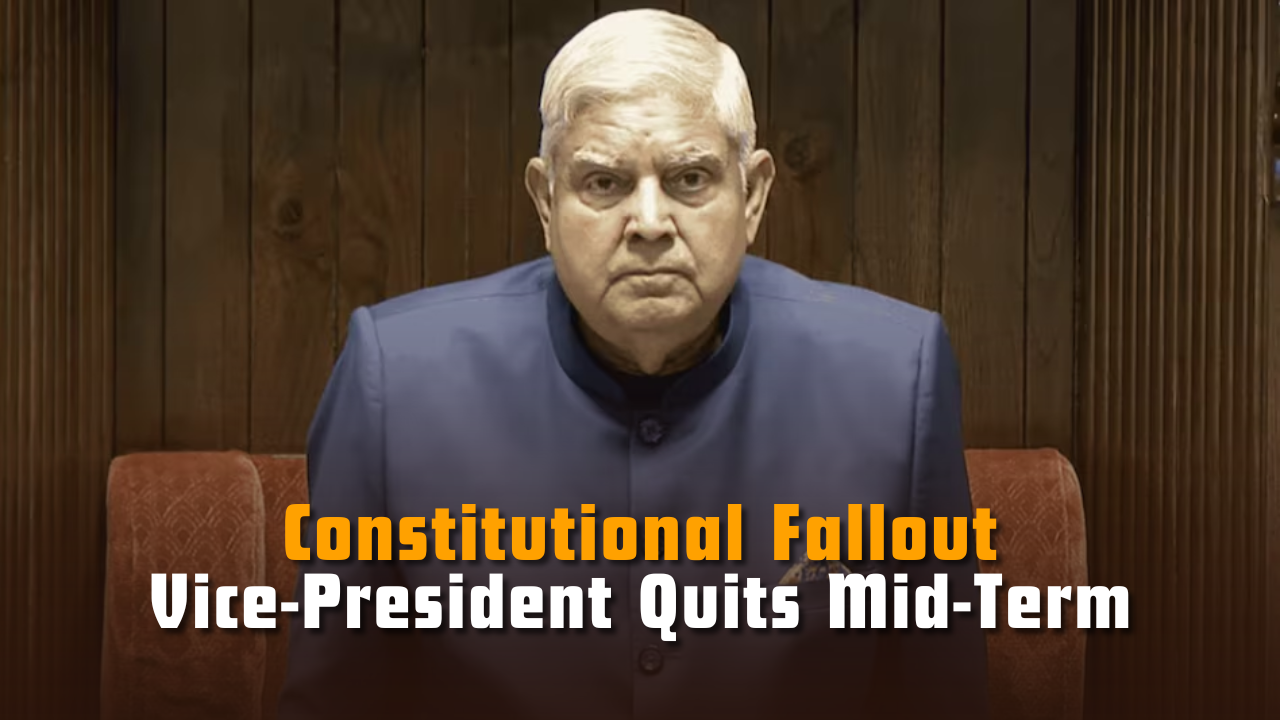Vice-President Steps Down Midway: Immediate Consequences and Legal Roadmap
Context: Vice-President Jagdeep Dhankhar resigned on July 21, 2025, citing health reasons in a letter submitted to President Droupadi Murmu.
Why is this development constitutionally significant?
- It creates a rare mid-term vacancy in the country’s second-highest constitutional office.
- It is the first time a Vice-President has resigned for health reasons rather than political ambition.
- It invokes interim procedures not frequently tested in constitutional practice.
[stextbox id=’info’]
Constitutional Provision and Historical Precedents
- His resignation came under Article 67(a) of the Constitution, which allows a Vice-President to resign by writing to the President. Article 63-71 deals with the election, duties, and resignation of the Vice-President.
- This marks only the third time in Indian history that a Vice-President has resigned mid-term. The previous instances were: V.V. Giri in 1969 (to contest the presidential election) & R. Venkataraman in 1984 (also to contest the presidency).
[/stextbox]
Who discharges the duties of the Vice-President in the interim?
- There is no provision for an “acting VP” under the Constitution.
- However, since the VP also serves as the ex-officio Chairman of the Rajya Sabha, the Deputy Chairman of the Rajya Sabha, currently Harivansh Narayan Singh, steps in to preside over parliamentary proceedings in the Upper House until a new VP is elected.
When will the election for the new VP be held?
- While there is no fixed deadline in the Constitution for electing a new VP, the Election Commission of India (ECI) is mandated to conduct the election “as soon as possible” after the vacancy.
- Unlike the Presidential office (which must be filled within 6 months under Article 62), the VP post has no time-bound stipulation, although political and procedural norms suggest a swift poll, likely within 60 days.
- Legal Framework: The Vice-Presidential election is conducted under the Presidential and Vice-Presidential Elections Act, 1952, with the Election Commission of India (ECI) announcing the schedule and the Secretary-General of either House serving as the Returning Officer.
Who is eligible to contest the Vice-Presidential election?
- As per Article 66(3) of the Constitution, a candidate for the Vice-President must: Be a citizen of India, Be at least 35 years old, Be qualified to be elected to the Rajya Sabha, Not hold any office of profit, except for certain posts like President, Governor, or Union Minister and The candidate need not be an MP or an MLA at the time of contest.
[stextbox id=’info’]
Where does the election take place and how is it managed?
- The election is held in Parliament House, New Delhi, under supervision of the Election Commission of India.
- The Secretary General of Lok Sabha or Rajya Sabha (on rotation) is appointed as the Returning Officer.
How has this situation been handled historically?
- Case Study: VV Giri (1969)
-
- Resigned as Vice-President to contest presidential polls
- Led to a heated presidential election after President Zakir Hussain’s death
- Case Study: R. Venkataraman (1984): Resigned mid-term for presidential bid, smooth transition followed
- In both cases, the ECI conducted elections swiftly and no disruption occurred in parliamentary functioning.
[/stextbox]
How is the VP elected?
- The Vice-President is elected by an electoral college consisting of:
- All members of Lok Sabha and Rajya Sabha, including nominated members
-
- State legislatures have no role
- Election Process:
-
- Secret ballot
-
- Proportional representation by means of a single transferable vote (STV)
- MPs rank candidates in order of preference
- The candidate securing a quota (total valid votes ÷ 2 + 1) is declared elected. Example: In 2022, Jagdeep Dhankhar won with 74.37% votes, the highest margin since 1992.
How long will the newly elected VP serve?
- The new Vice-President will serve a full five-year term starting from the date they assume office, not merely the remainder of Dhankhar’s term.
- This is in line with past precedents — Gopal Swarup Pathak (1969) and Shankar Dayal Sharma (1984) both served full terms after being elected mid-cycle.
Subscribe to our Youtube Channel for more Valuable Content – TheStudyias
Download the App to Subscribe to our Courses – Thestudyias
The Source’s Authority and Ownership of the Article is Claimed By THE STUDY IAS BY MANIKANT SINGH

Leave a Reply